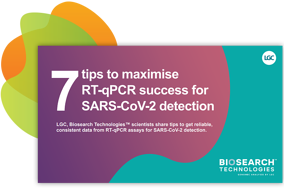Originally published : Tue, December 21, 2021 @ 10:54 PM
Updated : Thu, March 9, 2023 @ 5:39 PM
What’s changed for clinical labs as we enter the third year of COVID-19 testing?
COVID-19, the illness caused by SARS-CoV-2, has altered day-to-day life around the world and has been particularly disruptive for clinical labs. As we enter the third year of COVID-19 testing, resilient labs face new challenges, opportunities and questions. LGC, Biosearch Technologies™ explores how COVID-19 testing has changed since the height of the pandemic and offers insights into what’s ahead for clinical labs in its latest blog series.
The first blog post in the series discusses staffing challenges, an issue that continues to plague clinical labs.
Lab staffing challenges amid the pandemic
The COVID-19 pandemic has highlighted the need for more skilled lab workers. As virus testing continued into 2021, the effects on human resources became abundantly clear. Lab managers were forced to shuffle employees into new positions, train workers on new equipment and processes, and deal with staffing shortages as personnel fell ill with COVID-19. A global survey by Medical Laboratory Observer reports that 60% of labs had multiple staff members out sick with COVID-19 at the same time.
The strain on testing labs waxed and waned with every surge and lull of the pandemic. Some labs were underwater in specimens, hitting record numbers of processed tests.1 In some areas, 38% of labs had more staff than usual assigned to pre-analytical areas to keep up with the influx of SARS-CoV-2 tests but in other areas, 41% of labs were forced to enact temporary furloughs to compensate for lost revenue from delayed elective procedures and tests.2
Lab managers implemented new work arrangements, including shift work, new communication tools and more workplace flexibility, to overcome staffing challenges.3 With every spike in testing demand due to emerging variants of concern or seasonal drives such as flu or holiday travel, staff became overburdened and burnt out, causing an over-reliance on tired, stressed workers, increasing the risk of testing errors. Many labs weren’t prepared for the round-the-clock work and hadn’t planned for backup help to replace ill staff.
| Personal protective equipment shortages, improper microbiological techniques, lack of training and inadequate decontamination protocols or biosafety measures are more likely to occur when systems are overwhelmed and increase the risk of lab-associated COVID-19 infection.4 In addition to optimising COVID-19 diagnostics, labs continued to find ways to optimise lab safety for workers, including separating workers into isolated teams and developing makeshift spaces, especially for COVID-19 testing. |  Download expert guidance on how to optimise your RT-qPCR set-up for SARS-CoV-2 detection. Download expert guidance on how to optimise your RT-qPCR set-up for SARS-CoV-2 detection. |
The importance of solid, agile operations planning is one of the primary takeaways from the past two years. Looking ahead, lab managers will benefit from more robust staffing contingency plans that account for the circumstances that arose during the pandemic. The following questions should be top-of-mind as lab managers develop more robust operations plans:
- What disruptions have we experienced in the past, and which ones could we experience in the future?
- How will we maintain critical operations if our standard staffing plan is insufficient?
- Who can we recruit to support our laboratory staff in performing critical tasks?5
Biosearch Technologies supports clinical labs as they continue to navigate the COVID-19 pandemic. Our dedicated technical teams are developing innovative products, including the SARS-CoV-2 ultra-high-throughput End-Point RT-PCR Test, that can improve lab efficiencies to support increased testing volumes. The SARS-CoV-2 ultra-high-throughput End-Point RT-PCR Test automates sample accessioning without an extraction step before proceeding to amplification carried out on the Nexar™, Hydrocycler2™, and Araya™ instruments. This testing option is flexible to scale during the surges and lulls of the pandemic, with the capability of processing over 110,000 tests within a 24-hour period. Learn how Biosearch Technologies can help clinical labs keep up with fluctuating testing demands while reducing manual labour and optimising resource management.
References
- Wu K. ‘Nobody Sees Us’: Testing-Lab Workers Strain Under Demand. New York Times. Published December 3, 2020. Accessed December 21, 2021.
- Williams ML. Best practices while surviving COVID-19 chaos in the lab. Medical Lab Observer. Published March 24, 2021. Accessed November 1, 2021.
- Hanton S. COVID-19 laboratory challenges and learnings – one year later. Duke Human Vaccine Institute. Published May 4, 2021. Accessed November 3, 2021.
- Mardian Y, Kosasih H, Karyana M, et al. Review of current COVID-19 diagnostics and opportunities for further development. Front Med. Published May 7, 2021. Accessed November 1, 2021. https://doi.org/10.3389/fmed.2021.615099
- Toney D, Pentella M, Blank E, et al. Creating a blueprint for the future: lessons learned from public health laboratories in the COVID-19 response. Journal of Public Health Management and Practice. 27:p S101-S105. Published January 2021. Accessed November 4, 2021. https://doi.org/10.1097/PHH.0000000000001285.

